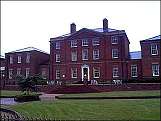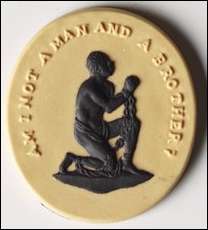|
When Fashion Promoted the Cause of
Humanity
an article from the
Wedgwood Review, courtesy of the Wedgwood
Museum, Barlaston Stoke-on-Trent, England.
"Throughout his life Josiah Wedgwood expressed an ardent concern
over the social and political upheavals which characterized the age in
which he lived. Such concern was not limited to his immediate
responsibilities, the welfare and working conditions of his employees
for example, but extended to the American War of Independence and the
French Revolution, amongst others. It is not surprising then that
towards the end of his life Wedgwood became actively involved with the
move towards the abolition of slavery.
From 1787 until his death in 1795,
Wedgwood actively participated in this cause, becoming a member of one
of the committees of the Society for the Abolition of Slavery. It is
probable that Wedgwood’s awareness of the immorality of the slave
trade and the necessity for its abolition developed in part through his
friendship with Thomas Bentley. It was Bentleys knowledge both of the
arts and sciences which influenced Wedgwood to a large extent, and he
was very much opposed to the slave trade despite the fact that he was a
Liverpool merchant, who stood to gain financially from it. He refused to
join with others in welcoming the slavers back to port and his feelings
most likely influenced Wedgwood’s thoughts on the topic. Following
Bentley’s death in 1780 Wedgwood subscribed to every pamphlet
concerned with the abolition of slavery and did all he could to help the
cause.
Further involvement in
the anti-slavery movement came about through Wedgwood’s association
with Thomas Clarkson, or the ‘friend of the slave’, as he came to
be known. Clarkson was instrumental in setting up the Sierra Leone
Company in 1791, which was to provide a colony for the habitation of
slaves who had been made free. In August 1791 Clarkson wrote to
Wedgwood telling him that he had at last been successful in securing
shares in the Sierra Leone Company for him: furthermore, he urged
Wedgwood to take ten shares instead of the eight he had originally
intended to buy. Wedgwood complied with Clarkson’s request and
became a shareholder in the Sierra Leone Company, simultaneously
demonstrating his support of the anti-slavery movement.
Wedgwood’s involvement with the
anti-slavery cause is well documented in his correspondence. In
particular, the exchange between Wedgwood and Thomas Clarkson gives
insight into Wedgwood’s feelings on the matter, and furthermore
indicates how he was able to contribute to the success of the movement.
In a letter written to Wedgwood on 9 January 1792 Clarkson suggests that
he might consider helping to persuade the public of the wrongs of the
slave trade — it seems from this that Clarkson was aware that
Wedgwood’s good social reputation could be used for the cause, in that
people would readily take note of his protests against the slave trade.
In his letter Clarkson discusses a pamphlet compiled by William Fox in
1791 called:
‘An address to
the People of Great Britain on the propriety of abstaining from West’
India sugar and rum’.
He writes of its value as a means of
encouraging petitions for the abolition of slavery and he goes on to
suggest that perhaps Wedgwood himself could ask a bookseller to
circulate the pamphlet.
Accordingly, Wedgwood replies on 18 January 1792 and suggests that the
appeal of the pamphlet could be further enhanced by the advertisement on
the title page being replaced by a print of the emblem of the Society
for the Abolition of Slavery.
For this reason he proposes to have a wood-cut made, at his own expense,
depicting the kneeling negro in mannacles, surrounded by the motto:
‘Am I not a man and a Brother’, and at the same time he orders 2,000
more pamphlets. It also becomes evident from the correspondence held in
the Wedgwood archives that on numerous occasions, Wedgwood met and
corresponded with William Wilberforce, the parliamentary leader for the
cause of the abolition of slavery. Wilberforce was ultimately
responsible for the passing of the bill enforcing the gradual abolition
of slavery and it is to Wedgwood’s credit that his comments on this
topic were apparently of much importance to Wilberforce. In several
letters written to Wedgwood and addressed to the Greek Street showroom
in Soho, Wilberforce welcomes comments made by the former in previous
communications and promises to give these ideas his ‘full support in
the House of Commons’.

Etruria Hall

Wilberforce was also a guest at Etruria
Hall and an entry in his journal dated 16 November 1791 speaks
flatteringly of the Wedgwood family, calling them a ‘fine, sensible,
spirited family intelligent and manly in behaviour.’
During this period Wedgwood was a
well-known, much-respected man and was therefore, sufficiently
influential to be able to convince friends and colleagues of the evils
of the slave trade.
Indeed, his most important contribution
to the movement for the abolition of slavery - the slave medallion - was
one which brought the attention of the public to the slave trade. The
production in 1787 of the slave medallion, a black and white Jasper copy
of the emblem of the Society for the Abolition of Slavery, modelled by
William Hackwood, shows how Wedgwood was able to adapt his craft for a
political function.

At the same time he is seen to have been
instrumental in turning popular feeling in favour of the movement. As
Clarkson remarked: ‘He made his own manufactory contribute to this
end’, and it is also Clarkson who records the effect of the medallion,
thousands of which had been distributed by 1791. Following the
adaptation of the medallion to adorn snuff boxes, hat pins and brooches,
Clarkson remarked: ‘Fashion, which usually confines itself to
worthless things was seen for once in the honourable office of promoting
the cause of justice, humanity and freedom’, and it is evident that
through the success of the medallion. Wedgwood had achieved, at least in
part, the desire to make known the suffering of the slave, for he
believed that knowledge of the evils of the slave trade would inspire
universal detestaion of its cruelty and conviction of its injustice.
Wedgwood sent a large number of cameos to
Benjamin Franklin in Philadelphia who also remarked on the value of the
medallion as a means of bringing awareness of the existence if slavery
to the public. Wedgwood had become acquainted with Franklin through his
association with the Lunar Society and the two men had much in common.
Franklin was particularly interested in the art of pottery and his
appreciation of Wedgwood’s art is seen from his reply to Josiah on
receipt of the gift of slave medallions. He writes: ‘I am distributing
your valuable present of cameos among my friends in whose countenances I
have seen such marks of being affected by contemplating the figure of
the Suppliant (which is admirably executed) that I am persuaded it may
have an effect equal to that of the best written pamphlet in procuring
honour to those oppressed people’."
 more on Wedgwood
more on Wedgwood
|
| index page for 'did you know? |